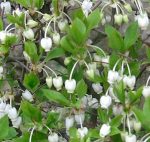 White enkianthus is a compact, deciduous, flowering shrub and a member of the heath family, Ericaceae, that ncludes azaleas, heather, and cranberry. Native to the woodlands of Japan it grows up to 6′ tall and wide and has shiny red twigs, reddish brown twigs, and branches arranged in tiers. The bright green, ovate leaves are 1-2″ long and clustered at the tips of the branches. They have finely toothed margins and midribs on the undersides that are downy at the base. In the fall the the leaves turn burgundy and then bright yellow and scarlet, but plants are variable and best purchased in the fall when the color can be evaluated. In spring, before the leaves emerge, pendent umbels of 3-10 pure white, urn-like flowers 1/4-1/3″ long appear on smooth 1/2″ long stalks. White enkianthus is valued for both its flowers and spectacular fall coloration and is a good choice for containers, borders, hedges, and woodland gardens. The genus name, Enkianthus, comes from the Greek words enkyos, meaning pregnant and anthos meaning flower, and refers to the swelling at the base of the corolla of some species. The specific epithet, perulatus, is the Latin word meaning provided with budscales and refers to the fact that the budscales of this species are consipicuous.
White enkianthus is a compact, deciduous, flowering shrub and a member of the heath family, Ericaceae, that ncludes azaleas, heather, and cranberry. Native to the woodlands of Japan it grows up to 6′ tall and wide and has shiny red twigs, reddish brown twigs, and branches arranged in tiers. The bright green, ovate leaves are 1-2″ long and clustered at the tips of the branches. They have finely toothed margins and midribs on the undersides that are downy at the base. In the fall the the leaves turn burgundy and then bright yellow and scarlet, but plants are variable and best purchased in the fall when the color can be evaluated. In spring, before the leaves emerge, pendent umbels of 3-10 pure white, urn-like flowers 1/4-1/3″ long appear on smooth 1/2″ long stalks. White enkianthus is valued for both its flowers and spectacular fall coloration and is a good choice for containers, borders, hedges, and woodland gardens. The genus name, Enkianthus, comes from the Greek words enkyos, meaning pregnant and anthos meaning flower, and refers to the swelling at the base of the corolla of some species. The specific epithet, perulatus, is the Latin word meaning provided with budscales and refers to the fact that the budscales of this species are consipicuous.
Type: Deciduous flowering shrub
Outstanding Feature: Autumn coloration; flowers
Form: Rounded
Growth Rate: Slow
Bloom: Clusters of pure white urnlike flowers in spring
Size: 6’H x 6′ W
Light: Full sun to partial shade
Soil: Average, medium moist, well-drained, acidic
Hardiness: Zones 6-8
Care: Low maintenance
Pests and Diseases: Generally healthy but susceptible to scale and spider mites
Propagation: Semi-hardwood cuttings
Outstanding Selections: ‘J.L. Pennock’ (fall coloration earlier than species)
Photo Credit:Wikimedia